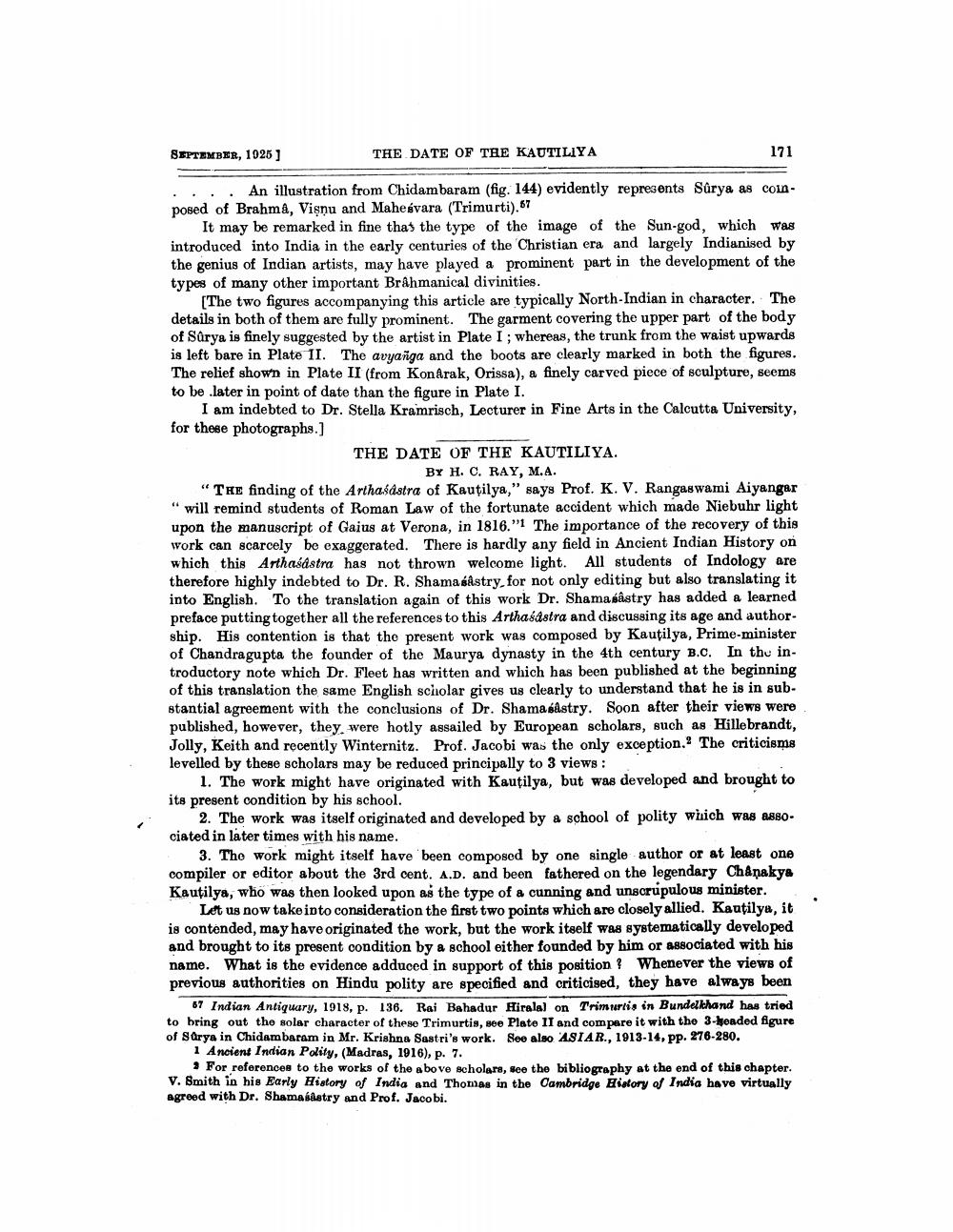________________
SEPTEMBER, 1025 )
THE DATE OF THE KAUTILIYA
171
.... An illustration from Chidambaram (fig. 144) evidently represents Sûrya as coinposed of Brahma, Vişnu and Mahesvara (Trimurti).67
It may be remarked in fine that the type of the image of the Sun-god, which was introduced into India in the early centuries of the Christian era and largely Indianised by the genius of Indian artists, may have played a prominent part in the development of the types of many other important Brahmanical divinities.
[The two figures accompanying this article are typically North Indian in character. The details in both of them are fully prominent. The garment covering the upper part of the body of Surya is finely suggested by the artist in Plate I ; whereas, the trunk from the waist upwards is left bare in Plate II. The avyañga and the boots are clearly marked in both the figures. The relief shown in Plate II (from KonArak, Orissa), a finely carved piece of sculpture, seems to be .later in point of date than the figure in Plate I.
I am indebted to Dr. Stella Kramrisch, Lecturer in Fine Arts in the Calcutta University, for these photographs.]
THE DATE OF THE KAUTILIYA.
BY H. C. RAY, M.A. “The finding of the Arthasastra of Kautilya," says Prof. K. V. Rangaswami Aiyangar "will remind students of Roman Law of the fortunate accident which made Niebuhr light upon the manuscript of Gajus at Verona, in 1816."1 The importance of the recovery of this work can scarcely be exaggerated. There is hardly any field in Ancient Indian History on which this Arthasdstra has not thrown welcome light. All students of Indology are therefore highly indebted to Dr. R. Shamasastry for not only editing but also translating it into English. To the translation again of this work Dr. Shamasastry has added a learned preface putting together all the references to this Arthasastra and discussing its age and author. ship. His contention is that the present work was composed by Kautilya, Prime-minister of Chandragupta the founder of the Maurya dynasty in the 4th century B.C. In thu introductory note which Dr. Fleet has written and which has been published at the beginning of this translation the same English scholar gives us clearly to understand that he is in substantial agreement with the conclusions of Dr. Shamasastry. Soon after their views were published, however, they were hotly assailed by European scholars, such as Hillebrandt, Jolly, Keith and recently Winternitz. Prof. Jacobi was the only exception. The criticisms levelled by these scholars may be reduced principally to 3 views :
1. The work might have originated with Kautilya, but was developed and brought to its present condition by his school.
2. The work was itself originated and developed by a school of polity which was a880. ciated in later times with his name.
3. The work might itself have been composed by one single author or at least one compiler or editor about the 3rd cent. A.D. and been fathered on the legendary Chanakya Kautilya, who was then looked upon as the type of a cunning and unscrupulous minister.
Let us now take into consideration the first two points which are closely allied. Kautilya, it is contended, may have originated the work, but the work itself was systematically developed and brought to its present condition by a school either founded by him or associated with his name. What is the evidence adduced in support of this position? Whenever the views of previous authorities on Hindu polity are specified and criticised, they have always been
07 Indian Antiquary, 1918, p. 136. Rai Bahadur Hiralal on Trimurtis in Bundelkhand has tried to bring out the solar character of these Trimurtis, see Plate II and compare it with tho 3-headed figure of Sarya in Chidambaram in Mr. Krishna Sastri's work. See also ASIAR., 1913-14, pp. 270-280.
1 Ancient Indian Polity, (Madras, 1916), p. 7.
For references to the works of the above scholars, see the bibliography at the end of this chapter. V. Smith in his Early History of India and Thomas in the Cambridge History of India have virtually agreed with Dr. Shamasastry and Prof. Jacobi.




